French Omelette

Oh la la! This French Omelette recipe takes 3 simple ingredients (eggs, salt, and butter) and turns them into a spectacular breakfast. Creamy, rich, and oh-so-French, this is a recipe that’s all about technique—but don’t worry, I’ll show you how to nail it.

Pin this recipe on Pinterest to save for later
Pin It!An American omelet is delicious, but there’s absolutely nothing about it that’s chic or elegant.
I mean, for one, there’s the spelling—”French omelette” sounds fancy, while “omelet” sounds positively gauche.
Then, there’s the fact that it’s almost always over-flowing with eleventy-billion different fillings.
Cheese, veggies, all the meats—an American-style omelet is usually over-the-top, especially if you’re ordering it at the kind of greasy spoon diner with pleather seats and sticky bottles of ketchup on the table.

What Is a French Omelette?
A French omelette has a certain je ne sais quoi—like French Onion Soup, Savory Crepes, and so many other French recipes. It’s a celebration of simple ingredients.
Eggs! Herbs! Butter! (Always with the butter in French cooking, right?) You can add some cheese if you like, but you don’t need to.
Rather than being cooked until they’re browned, French omelettes are cooked until they’re just set, giving them a creamy, custard-like texture completely unlike the American version.
They’re rolled into a log, and they have a glossy sheen that adds to that whole chic appeal they have going for them.
French omelettes have no brown spots and taste lusciously creamy, yet no cream is added. The texture is all about the way you cook the eggs.
You don’t even need to pile it with bacon, sausage, ham, and a full cup of shredded cheese to make it delicious.

How to Make a Classic French Omelette
When recipes call for a few simple ingredients, it means two things.
- First, use the highest quality ingredients you can find—every single one matters. Spring for the fancy European butter; shred your own cheese. This is a recipe where you’ll notice the difference.
- Second, it means that you’re about to make a recipe that relies heavily on technique and getting the little details right. (Don’t worry, though, I’ve got you covered!)
Tip!
If you have trouble visualizing written instructions, be sure to watch the video below. Once you see how it’s done, the written instructions in the recipe will make a lot more sense!
The Ingredients
- Unsalted Butter. If you only have salted butter on hand, you can use that; just keep in mind that you’ll want to add less salt for seasoning.
- Eggs. A French omelette is a fabulous way to use the fancy farm-fresh eggs from the farmers’ market.
- Cheese. This is optional, but if you like pairing your eggs with cheese, shredded cheddar, gruyere, fontina, or another melty variety is perfection in this recipe.
- Salt. I use kosher salt or a flaky sea salt, such as Maldon or fleur de sel. Add AFTER cooking the eggs for the best texture.
- Herbs. Use all chives or a mix of tender herbs like parsley, tarragon, and chives. (Ever wondered what to do with the chervil in your herb garden? A French omelette is the answer!)
The Directions

1. Crack the eggs into a bowl and beat them with a fork until completely blended (no whites!).

2. Melt the butter in the skillet, then add the beaten eggs.

3. Use a spatula to push the edges to the middle, working in a circular motion.

4. Once the omelette is mostly set, use the spatula to spread the remaining liquid over the top to distribute it evenly, then reduce the heat to low.

5. Sprinkle the cheese in the middle, then cover until it melts.


6. Gently loosen the omelette from the skillet, then fold and roll it into a log.

7. Plate, butter the top, and scatter salt and herbs over the top. ENJOY!
Tips for the Best French Omelette
- Use the Right Equipment. You’ll need an absolutely perfect, pristine 8-inch nonstick skillet to keep the omelette from sticking. You’ll also need a rubber spatula to keep that beautiful nonstick skillet pristine—metal will scratch it up!
- Don’t Whisk Air into the Eggs. You want to beat them enough that the eggs and yolks are fully incorporated, but not so much that air bubbles begin to form.
- Know When It’s Done. French omelettes should be pale yellow; they feel smooth on the outside (not dry) and they have a creamy, custard-like interior. There should never be brown spots on a French omelette!
Storage Tips
- To Store. It’s best to eat French omelettes right away, but if you do have leftovers, they can be refrigerated for 3 to 4 days.
- To Reheat. Place the omelette on a microwave-safe plate, cover it with a damp paper towel, and microwave until warmed through.
- To Freeze. French omelettes do not freeze well.
Storage Tips
Wrap leftovers in plastic wrap before storing them in the refrigerator. This will help the omelette retain its creamy texture.
Leftover Ideas
Cut leftover French omelettes into strips and add them to salads for a boost of protein. You can even use them instead of soft-boiled eggs in Niçoise Salad!
What to Serve With a French Omelette
- Meat. Eggs always pair well with breakfast meats like sausage and bacon. It might not be French, but I love serving an omelette with Air Fryer Bacon or Baked Bacon.
- Salad. For a bistro-style brunch, serve your French omelette with a simple salad like my Arugula Salad or Beet Salad.
- Vegetables. In the mood for cooked veggies instead of raw? Swap the salad greens for Roasted Asparagus or Sautéed Spinach.
- Something Sweet. I love a little sweetness for balance when I have something savory for breakfast. Keep it light with Fruit Salad or serve your omelette with a fluffy Buttermilk Blueberry Muffin on the side.
Recommended Tools to Make this Recipe
- Nonstick Skillet. Absolutely non-negotiable here! You really need a nonstick skillet to keep your omelette from sticking. This one is affordable and from a well-known brand (which is always a plus on Amazon!).
- Spatula. A silicone or nylon spatula (as opposed to plastic) won’t melt in a hot pan, nor will it scrape the nonstick finish like metal.
- Mixing Bowl. I love this glass set because it can be used for prep and for serving.

Did you make this recipe?
Let me know what you thought!
Leave a rating below in the comments and let me know how you liked the recipe.
Whip up this French omelette recipe today and say bonjour to your new favorite breakfast!

Frequently Asked Questions
French omelettes are cooked just until set, so they have a creamy, custard-like texture and no brown spots outside. They are rarely filled with anything other than a small amount of cheese, and they’re rolled into a log rather than folded in half for serving.
You can use olive oil, but butter is the traditional French method of making omelettes. It will also give you a richer flavor.
A French omelette should not be runny like the yolks in sunny-side-up eggs, but it should be just set so it’s still creamy and custardy; it will look a little wet on the inside.

French Omelette
Ingredients
- 1 tablespoon plus 1/2 teaspoon unsalted butter
- 3 large eggs
- 2 to 3 tablespoons shredded cheddar, gruyere, fontina, or similar melty cheese, optional
- Kosher salt or flaky sea salt, such as Maldon or fleur de sel
- 1 to 2 teaspoons finely chopped fresh chives or a mix of tender herbs
Instructions
- Get Ready: Gather all of your equipment and ingredients: You need an 8-inch nonstick skillet that is in PRISTINE CONDITION (the surface can’t be scratched up or the eggs will stick), a sturdy rubber spatula, and the plate you’ll be serving it on. This recipe moves fast and needs your full attention.
-
In a medium bowl, beat the eggs throughly, until no streaks of white remain and the mixture appears homogeneous. This will take 1 or 2 minutes. Try to mix without whipping air into them (a French omelet is not the time).
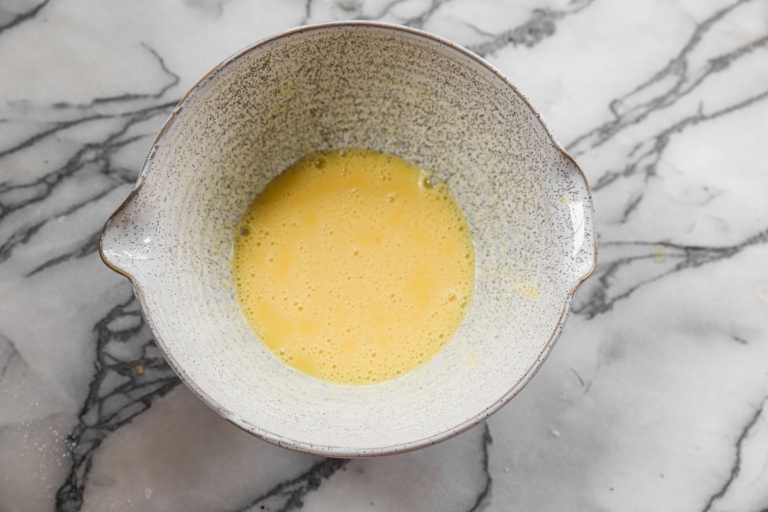
-
In the skillet, melt the butter over medium heat, swirling the skillet so that the butter forms a nice, even coating all over the pan. As soon as the butter starts to foam, pour the eggs into the center. The timing is key! You want the pan hot (but not too hot).
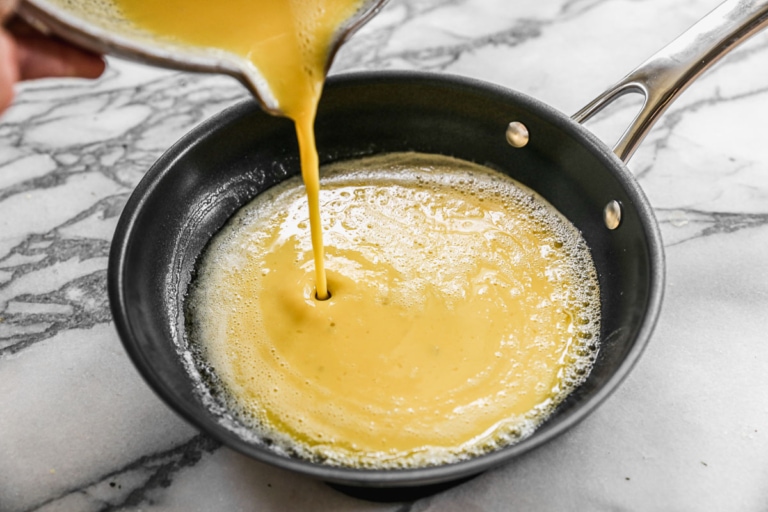
-
IMMEDIATELY use the rubber spatula to continually push bits of egg from all around the edges of skillet into middle. You might not seem much happening at first, but keep on going. You'll feel eggs begin to stick on the bottom as you move the spatula, then stick more and more as uncooked eggs flow to the pan's edges. Run the spatula in a circle around the edges as needed. The goal is to cook the eggs evenly and create a smooth skin on the bottom of the skillet.
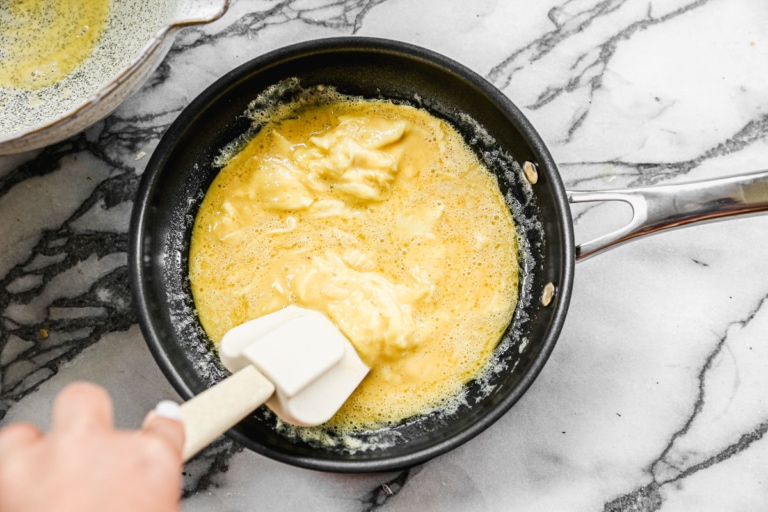
-
Once the eggs are almost cooked but you still have a small amount of liquid egg that can flow when you move the skillet, use spatula to smooth the remaining liquid portion evenly over the top of the set eggs to create a seal. Reduce the heat to low.
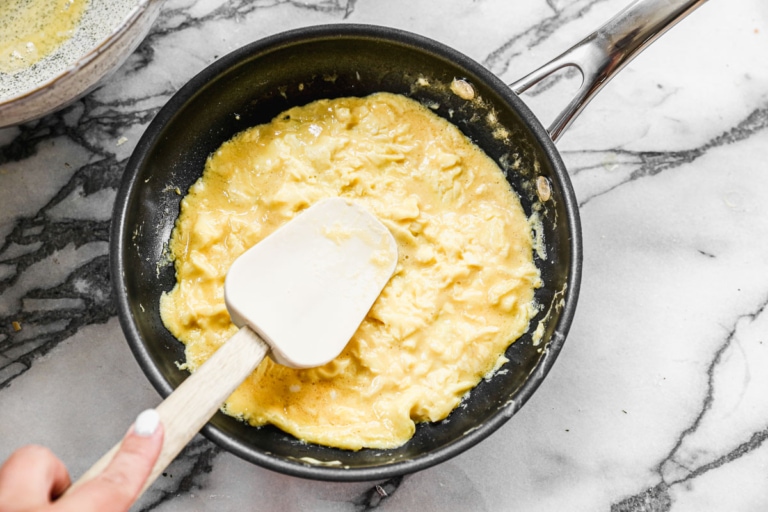
-
Sprinkle the shredded cheese in a 2-inch-wide strip down the center of the omelet so that the strip is running perpendicular to the skillet handle (this will allow you to roll the eggs around the filling as you shape the omelet). Cover the pan let sit over the lowest heat for 30 seconds to 1 minute—the eggs should still look shiny and a bit undercooked but not so wet that liquid can flow.
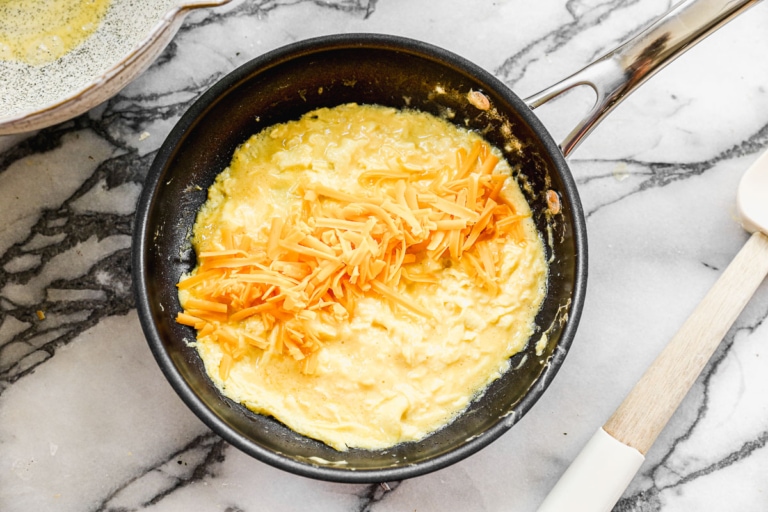
-
Remove the lid and use the spatula to gently loosen the cooked eggs from the surface of the skillet, starting at the edge closest to the handle. Work your way around the omelet to make sure it is completely loose (feel free to sneak a bit of butter under it if needed to help it release).
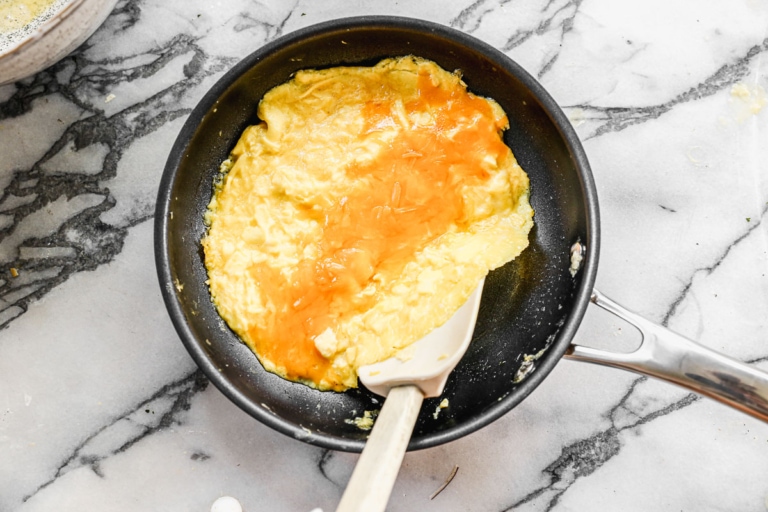
-
Use your spatula to fold the side of the eggs nearest to the skillet handle over the cheese, as if the omelet were a letter you were folding into thirds. With your fingers (be careful it's hot!) or the spatula, gently roll the omelet away from the handle into a tidy log. When you reach the end, you have two options: scoot the omelet to the far edge of the pan, then tilt it quickly down towards your plate at a 45-degree angle and use the spatula to slide it out of the pan so it lands on the plate in a tidy log with the seam-side down. OR, use the spatula fold to the loose end of the omelet up towards the center to complete the log, press it gently to adhere, then gently transfer the omelet to your plate, placing it seam-side down.
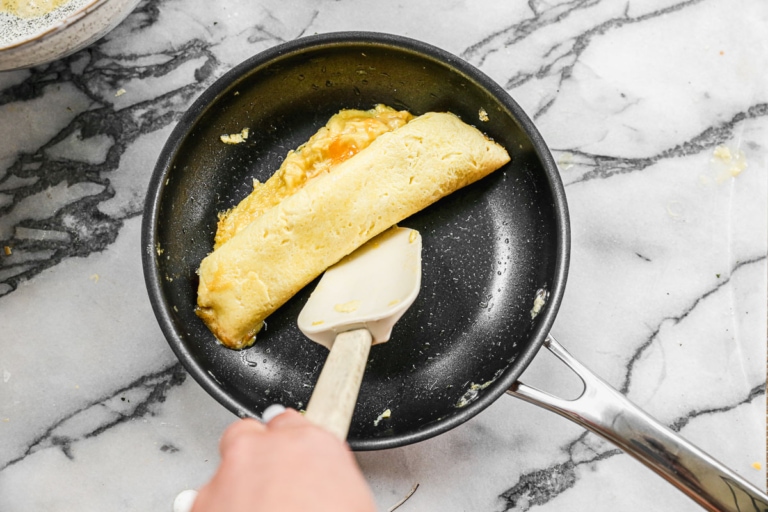
-
The omelet should be a beautiful pale golden color with no brown spots, smooth on the outside, and ultra creamy in the middle. Smear the remaining 1/2 teaspoon butter all over the outside of the omelet to make it shiny (and French!). Sprinkle with a pinch of salt and herbs as you please. Enjoy immediately.
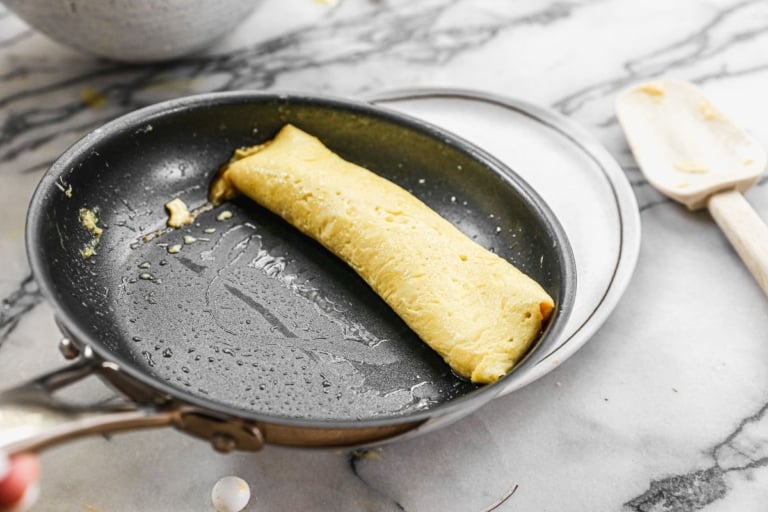
Video
Notes
- TO STORE: It’s best to eat French omelettes right away, but if you do have leftovers, it can be refrigerated for 3 to 4 days.
- TO REHEAT: Place the omelette on a microwave-safe plate, cover it with a damp paper towel, and microwave until warmed through.
- TO FREEZE: French omelettes do not freeze well.
Nutrition
Related Recipes
Eggs are packed with protein, making them a great way to start your day! Here are some of my favorite healthy egg recipes:




Leave a comment